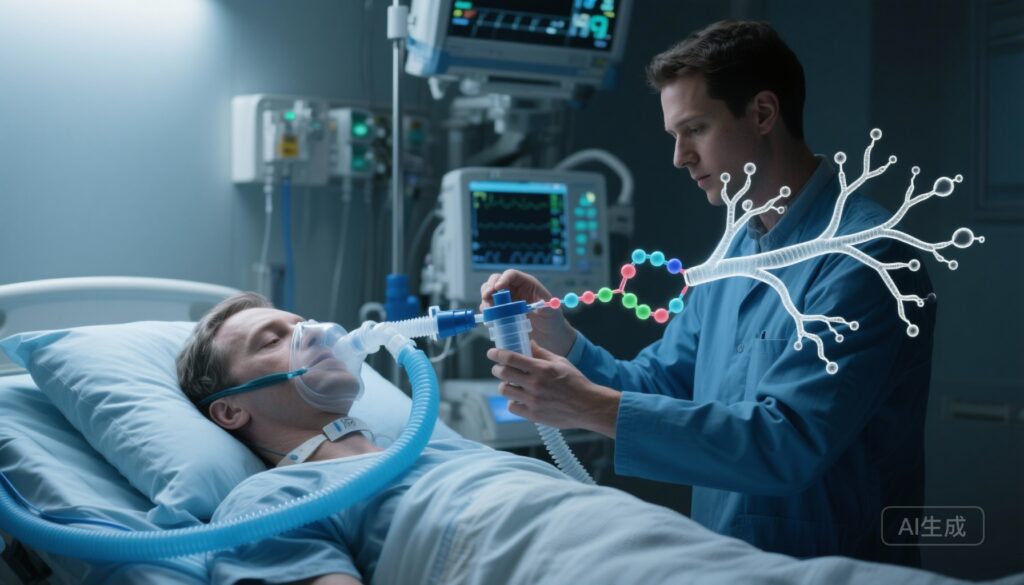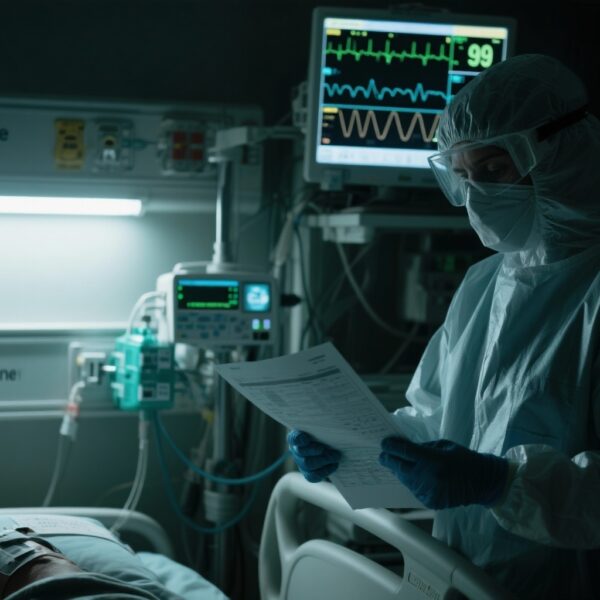Highlights
– Inhaled PEG‑adrenomedullin (PEG‑ADM) was well tolerated in mechanically ventilated ARDS patients; adverse event rates were similar to placebo.
– The trial demonstrated no improvement in the pre‑specified composite clinical utility index or ventilator‑free survival at Day 28; the study was stopped early for futility.
– Ventilator‑free survival at Day 28 was 52% in the PEG‑ADM 960 μg group, 67% in the PEG‑ADM 1920 μg group, and 65% in the placebo group; overall mortality and continued ventilation at Days 28 and 60 did not differ significantly between groups.
Background
Acute respiratory distress syndrome (ARDS) remains a common, life‑threatening complication of critical illness characterized by diffuse alveolar injury, increased pulmonary vascular permeability, hypoxaemia, and severe respiratory failure. Despite improvements in supportive care — notably lung‑protective ventilation and conservative fluid strategies — pharmacologic therapies that consistently improve clinical outcomes in ARDS have been elusive. Mortality remains substantial, and patients frequently require prolonged mechanical ventilation, which drives morbidity and resource use.
Adrenomedullin (ADM) is an endogenous vasoactive peptide with pleiotropic effects relevant to ARDS pathophysiology. In experimental models ADM shows vasodilatory activity, endothelial barrier stabilization, and anti‑inflammatory properties that could theoretically reduce pulmonary oedema and improve oxygenation. PEGylation (attachment of polyethylene glycol) increases peptide half‑life and may improve delivery when administered by inhalation. Translating promising preclinical biology into clinically meaningful benefits in human ARDS is challenging, and rigorous randomized trials are required to assess safety and efficacy.
Study design
This Phase 2a/b randomized, double‑blind, placebo‑controlled multicentre trial (SEAL Trial Investigators) evaluated inhaled PEG‑ADM in adult critically ill patients with ARDS receiving invasive mechanical ventilation. Ninety patients were randomized in the first part of the trial to one of three arms: PEG‑ADM 960 μg (n = 29), PEG‑ADM 1920 μg (n = 30), or placebo (n = 31). The trial design and objectives were prespecified, with primary endpoints assessing safety and efficacy and ventilator‑free survival at Day 28. Efficacy was assessed both by ventilator‑free survival and by a composite clinical utility index integrating physiologic measures (extravascular lung water index, oxygenation index) and systemic organ dysfunction (non‑pulmonary Sequential Organ Failure Assessment score).
The study was double‑blind and multicentre, improving internal validity, and used clinically relevant and patient‑centred endpoints. The trial registration number is ClinicalTrials.gov: NCT04417036 (registered 4 June 2020).
Key findings
Population and safety: Ninety patients were enrolled and randomized across the three groups. Both doses of inhaled PEG‑ADM were well tolerated; the frequency and nature of adverse events and serious adverse events were similar to placebo. There were no unexpected safety signals attributable to inhaled PEG‑ADM reported in this first randomized clinical experience in ARDS patients.
Primary efficacy outcomes: The trial failed to demonstrate efficacy on the prespecified clinical utility index — there was no significant improvement with either PEG‑ADM dose compared with placebo. Ventilator‑free survival at Day 28 was numerically lower in the PEG‑ADM 960 μg group (52%) compared with PEG‑ADM 1920 μg (67%) and placebo (65%). Despite these numerical differences, the study did not show statistically significant or clinically robust improvements associated with PEG‑ADM therapy. There were no significant differences in overall mortality or in the proportion of patients requiring continued mechanical ventilation at Days 28 and 60.
Trial course and decision to stop: Given the lack of signal on the composite endpoint and ventilator‑free survival, the trial was terminated early after the first part for futility. The decision reflects prespecified interim analyses and stopping rules intended to avoid exposing additional patients to an intervention without demonstrable benefit.
Interpretation of effect sizes: The absence of significant differences in mortality and continued ventilation suggests that, at the tested doses and administration strategy, inhaled PEG‑ADM did not produce clinically meaningful benefit. The unexpected lower ventilator‑free survival in the lower‑dose arm is likely a chance finding in a relatively small sample but highlights the importance of adequate sample size and balance in randomized groups. Confidence intervals and formal p‑values for between‑group comparisons were not provided in the summary, which limits quantitative appraisal here.
Secondary and exploratory observations
No consistent improvement was observed in physiologic components of the composite index (extravascular lung water index, oxygenation index), nor in measures of non‑pulmonary organ dysfunction. The lack of a biological signal on these intermediate outcomes weakens the likelihood that a clinically important effect was missed due to sample size alone, though the study was not powered for small effects.
Expert commentary and contextual interpretation
Biologic plausibility and translational challenges: The rationale for ADM in ARDS — endothelial barrier protection and reduction of pulmonary oedema — is plausible based on experimental data. However, successful translation of endothelial‑stabilizing agents into patient benefit in ARDS has been difficult. Potential explanations include timing (therapy too late after injury), heterogeneity of ARDS etiologies and host responses, pharmacokinetics and delivery limitations (inhaled peptides may not reach injured, consolidated lung regions), and opposing systemic effects (for example, vasodilation) that might mitigate lung‑specific benefits.
Dose‑response and administration: The trial tested two doses and found no dose‑responsive benefit; the higher dose had numerically similar outcomes to placebo and numerically better ventilator‑free survival than the lower dose. These findings argue against a simple underdosing explanation, but they do not exclude complex non‑linear pharmacodynamics or differences in penetration to affected lung units.
Design strengths and limitations: Strengths include randomized double‑blind design, multicentre participation, and clinically meaningful endpoints. Key limitations are the relatively small sample size, early discontinuation (reducing power), potential baseline imbalances, and the composite clinical utility index which — while comprehensive — may dilute signal if components move in opposite directions. Also, the trial summary does not report subgroup or biomarker analyses (for example, baseline ADM levels, markers of endothelial injury) that could identify responder phenotypes.
Implications for practice: The available evidence does not support routine use of inhaled PEG‑ADM for ARDS outside of clinical trials. The favourable safety profile is reassuring for any potential future studies, but clinicians should not expect improved ventilator‑free survival or mortality benefit based on current data.
Future research directions
Further development of ADM‑based therapies would benefit from addressing translational barriers: enriched or biologically stratified patient selection (for example, patients with biomarkers indicating endothelial leak), earlier initiation of therapy, optimized delivery systems ensuring peptide deposition in poorly aerated lung regions, and comprehensive pharmacokinetic/pharmacodynamic profiling in critically ill lungs. Adaptive trial designs and robust intermediate biomarkers (extracellular lung water, validated endothelial injury markers) could help identify signals more efficiently before committing to large phase 3 studies.
Given the broad history of negative pharmacologic ARDS trials despite encouraging preclinical data, investigators should be circumspect in interpretation and pursue rigorous mechanistic and dose‑finding work before large outcome trials.
Conclusion
This randomized Phase 2a/b trial found inhaled PEG‑adrenomedullin to be safe and well tolerated in mechanically ventilated ARDS patients but provided no evidence of improved clinical outcomes or ventilator‑free survival at Day 28; the study was stopped early for futility. The findings highlight the persistent challenge of translating endothelial‑protective biology into meaningful clinical benefit in ARDS. Further preclinical and early‑phase clinical work would be required to refine dosing, delivery, timing, and patient selection before re‑attempting outcome trials.
Funding and clinical trial registration
Trial registration: ClinicalTrials.gov NCT04417036 (date of registration: 4 June 2020). Funding sources and detailed sponsor information are reported in the original publication (Karagiannidis et al., Crit Care 2025) and should be consulted for potential conflicts of interest and sponsor involvement.
References
1) Karagiannidis C, McAuley DF, Thompson BT, Reimer T, Shakery K, Schmitz S, Cortés MN, Ullrich R, Meziani F, Mercat A, Chiumello D, Duska F, Combes A; SEAL Trial Investigators. Safety and efficacy of inhaled PEG‑ADM in ARDS patients: a randomised controlled trial. Crit Care. 2025 Oct 23;29(1):448. doi: 10.1186/s13054-025-05617-y. PMID: 41131549; PMCID: PMC12551264.
2) Ranieri VM, Rubenfeld GD, Thompson BT, et al. Acute respiratory distress syndrome: the Berlin Definition. JAMA. 2012;307(23):2526–2533.
3) The ARDS Network. Ventilation with lower tidal volumes as compared with traditional tidal volumes for acute lung injury and the acute respiratory distress syndrome. N Engl J Med. 2000;342:1301–1308.



